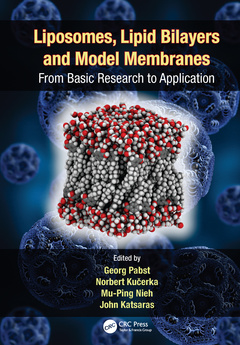Description
Liposomes, Lipid Bilayers and Model Membranes
From Basic Research to Application
Language: English
Subjects for Liposomes, Lipid Bilayers and Model Membranes:
Keywords
Lipid Bilayers; American Chemical Society; protein; DOPC; phase; Nonlamellar Phase; diagram; Reverse Micelles; hydrophobic; Lamellar Phase; mismatch; Tethered Lipid Bilayers; lamellar; CPP; molecular; Solid Lipid Nanoparticles; dynamics; HII Phase; simulations; Sponge Phase; hexagonal; MD Simulation; Lα Phase; Bicontinuous Microemulsions; Phase Diagram; Membrane Proteins; Outer Leaet; Halobacterium Salinarum; Membrane Curvature; LNP System; Extractant Molecules; PEGylated Liposomes; LNP Formulation; Red Blood Cell; Bilayer Simulations
Publication date: 10-2016
· 17.8x25.4 cm · Paperback
Publication date: 03-2014
432 p. · 17.8x25.4 cm · Hardback
Description
/li>Contents
/li>Readership
/li>Biography
/li>
As a result of their unique physical properties, biological membrane mimetics, such as liposomes, are used in a broad range of scientific and technological applications. Liposomes, Lipid Bilayers and Model Membranes: From Basic Research to Application describes state-of-the-art research and future directions in the field of membranes, which has evolved from basic studies of the physicochemical properties of amphiphiles to their application in industry and medicine. Written by leading researchers in their fields, this book describes basic and applied research, and serves as a useful reference for both the novice and the expert.
Part one covers a range of basic research topics, from theory and computational simulations to some of the most up-to-date experimental research. Topics discussed include soft matter physics of membranes, nonlamellar phases, extraction of molecules by amphiphiles, lipid models for membrane rafts, membrane dynamics, nanodiscs, microemulsions, active membranes, as well as interactions of bilayers with drugs or DNA to treat disease or for gene transfer, respectively.
Part two of the book focuses on technological applications of amphiphiles, such as liposome-based nanoparticles for drug delivery, formulation of liposomes for prolonged in vivo circulation and functionalization for medical purposes, novel drug delivery systems for increased drug loading, and the use of tethered membranes for bio-sensing applications. Chapters also describe the use of liposomes in textile dyeing and how lipidic nanoparticles are used by the food industry.
PART 1Basic Research Topics. Soft Matter Physics of Lipid Membrane-Based Assemblies.Nonlamellar Lipid Aggregates.Extractant Molecules as Hosts in Surfactant Monolayers or Bilayers.Molecular Dynamics of Lipid Bilayers: Standards, Successes, and Works in Progress.New Insights into the Peptide-Membrane Partitioning Equilibrium from In Silico Free Surface-to-Bilayer Peptide Insertion.Basic Aspects and Applications of Lipids and Protein Dynamics.Lipid Diversity and Its Implications on Membrane Organization.Liposome-Based Models for Membrane Rafts: Methodology and Applications.Nanoscale Membrane Mimetics for Biophysical Studies of Membrane Proteins. Microemulsions: Biomimetic Systems for Characterization of Biomembranes and Their Associated Biomolecules.Locations of Small Biomolecules in Model Membranes.Membrane Medicine.The Structural Diversity of DNA–Phospholipid Aggregates. An Update on Active Membranes. PART 2 Technology. Medical Applications of Lipid Nanoparticles.Polymer-Modified Liposomes: From Long-Circulating to Multifunctional.Drug Formulations Based on Self-Assembled Liquid Crystalline Nanostructures.Tethered Lipid Membranes.Ion-Transporting Supported and Tethered Lipid Bilayers That Incorporate Biological Membrane Transport Proteins.Role of Liposomes in Textile Dyeing. Micro- and Nanoparticles for Controlling Microorganisms in Foods. Index.
Georg Pabst received his Ph.D. in physics from the Graz University of Technology, Austria, and completed postdoctoral research at the Canadian Research Council, Chalk River, Ontario. After his return to Austria, he was a senior research officer at the Austrian Academy of Sciences and moved to the University of Graz, where he currently holds the position of assistant professor. His research is focused on the physics of biological membranes with the aim of delineating the functional role of membrane lipids in cellular transport and signaling.
Norbert Kučerka received his Ph.D. in biophysics from the Faculty of Mathematics, Physics and Informatics at Comenius University in Bratislava, Slovakia, in 2003. He completed his postdoctoral research at the Department of Physics, Carnegie Mellon University in Pittsburgh, Pennsylvania, and as a National Sciences and Engineering Research Council visiting fellow at the Canadian Neutron Beam Centre, Chalk River, Ontario. In 2008, he joined the National Research Council of Canada, recently becoming an associate research officer. His work is focused on determining the structure of biological model membranes and unraveling the structure–function relationships in their highly complex behavior.
Mu-Ping Nieh received his Ph.D. in the Department of Chemical Engineering at the University of Massachusetts, Amherst, USA. He then worked as a postdoctoral researcher—a joint position at National Institute of Standards and Technology and The Pennsylvania State University. In 2002, he joined the National Research Council, Canada, at Chalk River, Ontario. Eight years later (2010), he became an associate professor in the Department of Chemical and Biomolecular Engineering at the University of Connecticut, Storrs, USA. His research primarily focuses on the underlying principles of spontaneous structures formed by soft materials, including lipids, polymers, and proteins, seeking a fundamental understan




